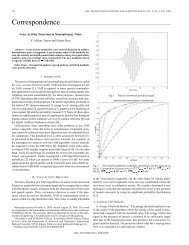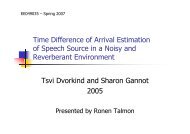Thesis (PDF) - Signal & Image Processing Lab
Thesis (PDF) - Signal & Image Processing Lab
Thesis (PDF) - Signal & Image Processing Lab
Create successful ePaper yourself
Turn your PDF publications into a flip-book with our unique Google optimized e-Paper software.
6.4. APPLICATION EXAMPLES 99<br />
6.4 Application examples<br />
A common usage of opening and opening by reconstruction operators is cleaning noisy<br />
images as an intermediate step in various applications. Our operators, defined on<br />
extrema watershed tree, have an important feature: duality. In the next paragraphs<br />
we will show a number of possible applications that may use the EWT-based filtering<br />
as an intermediate step. The presented applications are OCR (Optical Character<br />
Recognition) algorithms and dust and scratch removal from images.<br />
6.4.1 Pre-processing for car license plate number recogni-<br />
tion<br />
Morphological operators are a common choice for applications that require image<br />
simplification. One kind of such an application is pre-processing for OCR (Optical<br />
Character Recognition) algorithms. We have chosen a specific OCR algorithm, used<br />
for recognition of license plate numbers, that was developed in [25]. This algorithm<br />
uses a mask for each digit and looks for the best correlation among these masks with<br />
an image. Any noise that exists in the image degrades the correlation value and<br />
interferes with the recognition.<br />
This particular algorithm has an important benefit: it calculates a coefficient of<br />
recognition quality. This coefficient enables us to measure recognition improvements,<br />
when using different pre-processing algorithms. The exact definition of this coefficient<br />
is presented in [25].<br />
Consider an example license plate shown in Fig. 6.29. This image is corrupted with<br />
different kinds of noise, see Fig. 6.30. The correlation is done on the gray scale image<br />
shown in Fig. 6.31. It is difficult to automatically recognize the numbers without pre-<br />
processing, because of the noise level. We have done opening by reconstruction, using<br />
the structuring element shown in Fig. 6.28. The diameter of this SE is equal to the<br />
width of digits lines. This size of SE assures that we filter as much noise as possible<br />
without damage to the numbers. The resulting image can be seen in Fig. 6.32. In<br />
this figure, almost all the noise is gone, and the image is much clearer and suitable<br />
for OCR. The effect of the proposed pre-processing can be seen in table 6.1. Without<br />
the pre-processing, the OCR failed to recognize correctly the plate number. The pre-<br />
processing, not only removes the noise, but also simplifies the image. Therefore, when
















